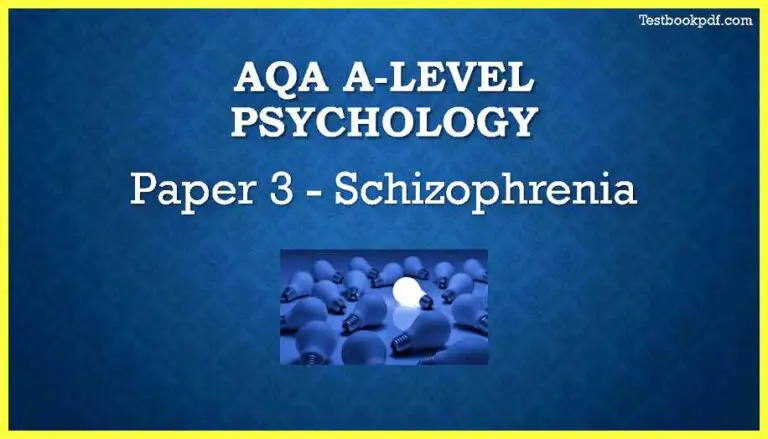AQA A-Level Psychology Paper 3 Schizophrenia
In This article, we’ll discuss schizophrenia AQA A-Level Psychology Paper 3 Schizophrenia or we can say that This is part of paper 3 of AQA’s a-level scope of psychology So, let’s Start.
Classification of schizophrenia
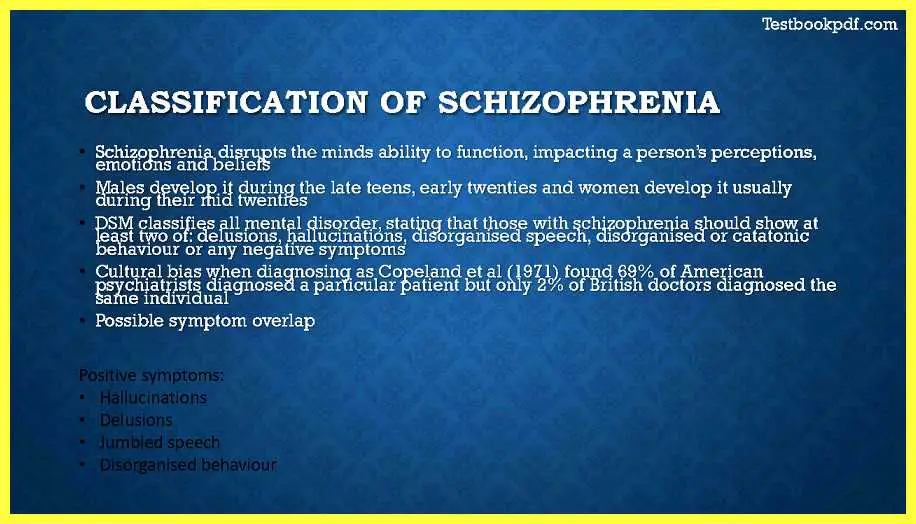
So if schizophrenia disrupts the abilities of the mind function impacting a person’s perceptions emotions and beliefs males tend to develop it during their late teens to early 20s whereas women develop it during their mid-20s and the DSM classifies all mental disorders stating that those with schizophrenia should show at least two of delusions of hallucinations disorganized behavior disorganized speech sorry disorganized or catatonic behavior or any negative symptoms cultural bias various cultural bias when diagnosing as Copland a towel in 1971 found 69% of American psychiatrists diagnosed particular patient but only 2% of British doctors diagnose the same individual and obviously there can be possible symptom overlap.
So positive symptoms include hallucinations delusions jumbled speech and disorganized behavior obviously this is not these aren’t good symptoms to have but apart from positive, it means that adding something individual rather than taking something away and then negative symptoms is speech poverty lack of emotion abolition which is basically disinterest in activities and lack of ability to function normally.
So if you see the difference positive symptoms add something to the person even if it’s not necessarily adding a good thing whereas negative symptoms take something away.
Biological explanations
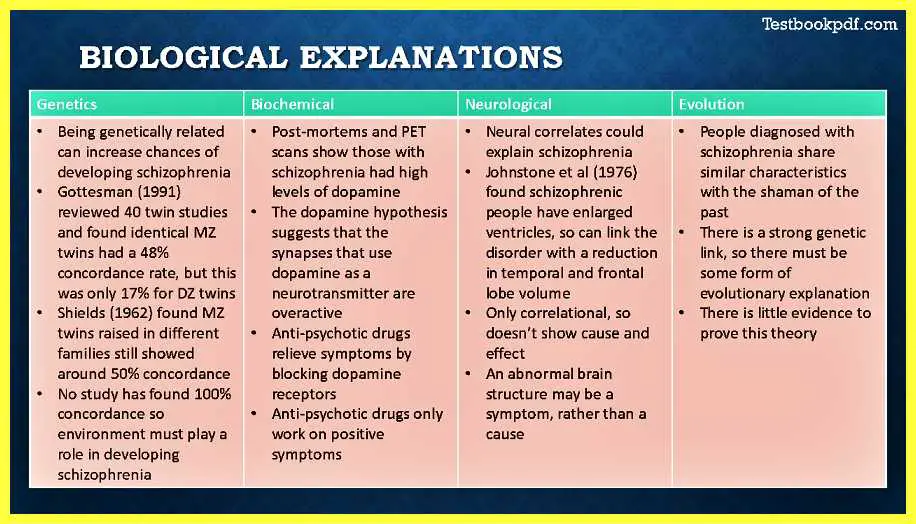
So here are a few biological estimation firstly genetics so being genetically related can increase chances of developing schizophrenia so I think for example I’m my uncle is actually schizophrenic and I believe I have about a 10% chance of getting hits every Nia got asthma in 1991 reviewed 40 twin studies and found an identical MZ twin found identical MZ twins had a 40 percent concordance rate but this was only 17% for desert winds shields in 1962 found MZ twins race and different family she’ll still show around 50 thanked accordance, Wellesley, no study has found 100 sent according to the environment must play a role in developing schizophrenia looking at biochemical.
So post mortems and PE T scans have shown that those who schizophrenia had high levels of dopamine leading to the dopamine hypothesis which assesses that this sign-up says they use dopamine as a new neurotransmitter or overactive antipsychotic drugs can release symptoms by blocking dopamine receptors but they only work on positive symptoms looking at neurological so neural correlates could explain schizophrenia so Johnston a tower in 1976 fans get frantic people have enlarged ventricles.
So I can link the disorder with the reduction in temporal and frontal lobe volume however this is only a correlation also does not necessarily show cause and effect and an abnormal also an abnormal brain structure may be a symptom rather than a cause and then lastly looking at evolution and people diagnosed with schizophrenia share similar characteristics with the shaman of the post office of the head I cannot remember what a man is but if you look up there before would be a lot of information there is a strong genetic link there must be some form of evolutionary explanation but there is little evidence to prove this theory obviously evolution is probably not something they’ll likely RT about it was only sort of small section in the CDP see GP revision guide.
Psychological explanations
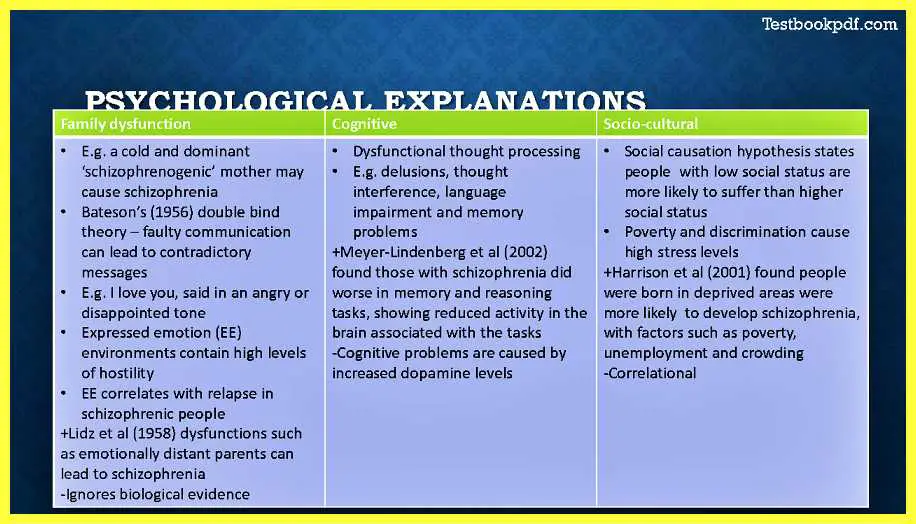
First, you’ve got family dysfunction so, for example, a cold and dominant schizophrenic, a schizophrenic friend of the genic mother may cause schizophrenia Bateson’s 1990 56 double bind theory looks like the idea that faulty communication can lead to contradictory messages there Rowe samples the mother saying I love you in an angry or disappointed tone and you’ve also got expressed emotion and these expressed emotion environments can contain the high levels or history of hostility and also criticism for the individual and this expressed emotion correlates with relapse in schizophrenic people blitz a towel in 1958 scientist functions such as emotionally distant parents can lead schizophrenia but ignores biological evidence and cognitive.
So this is dysfunctional thought processing such as delusions thought interference and language impairment and memory problems Maya Lindenberg a towel in 2002 found those kids from us it’s free Nia did worsen memory and reasoning tasks showing reduced activity in the brain associated with the task and cognitive problems are caused by increased dopamine levels however and then social cultural.
So this look at the social causation hypothesis which states people with low social status are more I’d stuff with higher social status than higher social status and this can be a result of discrimination causing high-stress levels in support of this Harris in a towel in 2001 from people born into deprived areas were more like developing schizophrenia with factors such as poverty unemployment and crowding how it is only correlational they’re looking at the Diathesis-stress model.
Diathesis-stress model
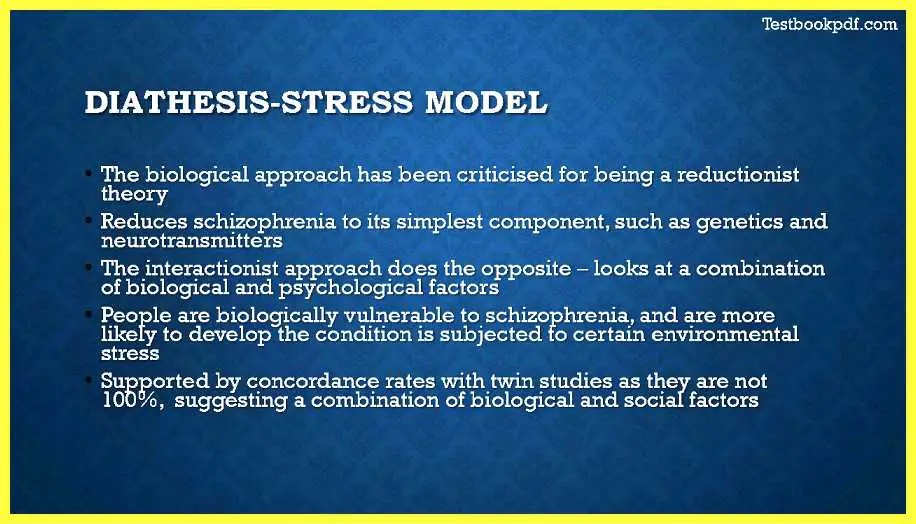
So the biological approach has been criticized for being a reductionist theory as it reduces schizophrenia to the simplest components such as genetics and neurotransmitters however the interactions of pro interactionist approach does the opposite it looks at a combination of biological and psychological factors people are biology and biologically vulnerable to schizophrenia and ammolite of that develop the patient the condition if subjected to certain environmental stress the ported by concordance rates with print studies as they are not on absinthe suggesting a combination of biological and social factors but I believe I will be speaking more about the interactionist approach at the end on the last Image for this article.
Drug therapy
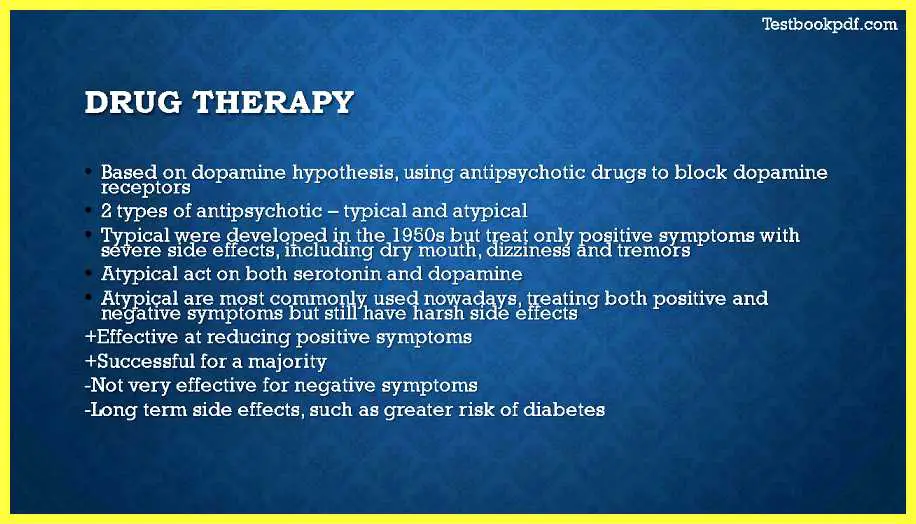
This is based on the dopamine hypothesis that we spoke about earlier using antipsychotic drugs to block dopamine receptors and there are two types of antipsychotic drugs typical and atypical typical were developed in the 1950s but treat only positive symptoms with severe side effects including dry mouth dizziness and tremors a tick bubbles a typical sorry ya know um typical also only treated positive symptoms using dopamine and then a typical antipsychotic drug came along in the 1970s mainly using both serotonin and dopamine and this allows it to treat both positive and negative symptoms but it does still have hot very harsh side effects.
so obviously strengths are effective at reducing positive symptoms and are successful for the majority but they are not rotated for negative symptoms and it can hit long-term side effects such as the greater risk of diabetes and then looking at cognitive behavior therapy and Family Therapy
Cognitive Behaviour Therapy and Family Therapy
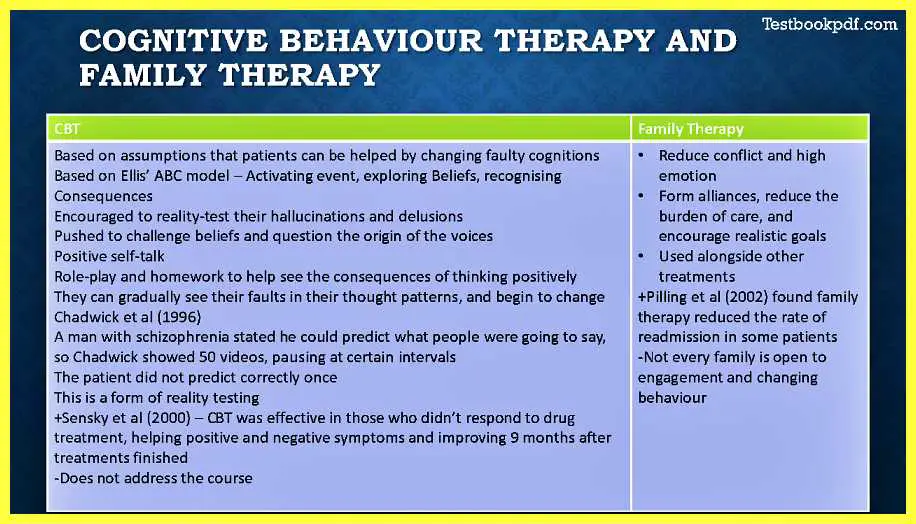
So CBT is based on assumptions that patients can be helped by changing faulty cognitions based on Alice’s ABC model so activating events exploring beliefs and recognizing consequences am encouraged to reality test there are loose nations and delusions push the challenged beliefs and question the origin of the voices encouraged to engage in positive self-talk roleplay and homework are encouraged to help see the consequence of thinking positively they can gradually see their faults in their thought patterns and begin to change Chadwicks at our well sorry I’m looking Chadwicks at our in 1996 literate studied a man with schizophrenia and stating he who stated he could predict what people were going to say though Chadwick showed in video 50 videos pausing at certain intervals and the patient did not predict correctly once.
So this is a form of reality testing and support from this comes from sense key at our 2000 so CVT was affected in those who didn’t respond to drug treatment helping positive and negative symptoms and will continue to continue to improve nine months after treatments finished, however, it does not address the cause I’ve completed I’ve written courses and studying not causes in the course so sorry I’ve I’m aware there are a few spelling mistakes and hear me sorry I’m just trying to get these videos out.
So as quickly as possible and then family therapy reduces conflicts and high motion to form alliances reduces the burden of care and encourages realistic goals and is often used alongside other treatments such as drug therapy and pilling our 2002 found family therapy reduces the rate of readmission in some patients but not every family is open to engagement and changing their behavior which is one of the mold difficult sides birth then looking at the token economy.
Token economy
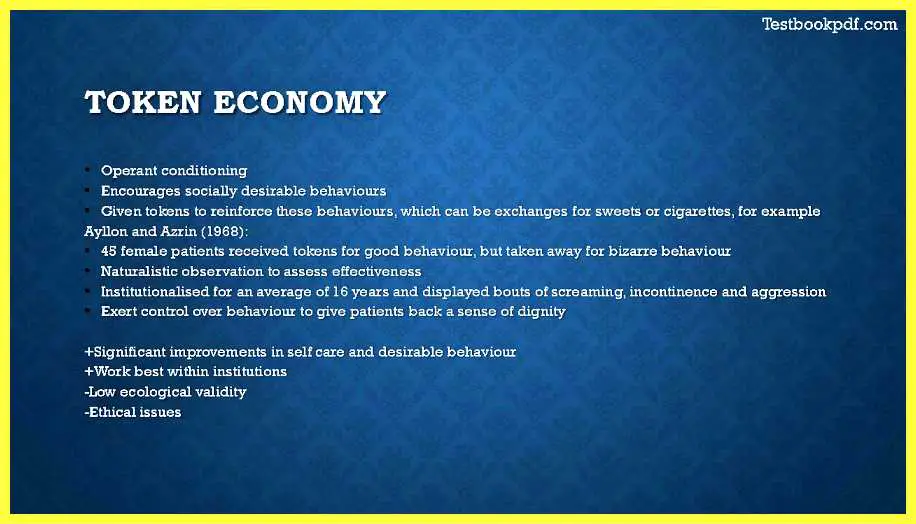
So this is based on opera conditioning encourages socially desirable behaviors and so basically the individuals are given tokens to reinforce behaviors which can be exchanged for sweets or cigarettes for example then Iman and Azrin in 1968 and 45 female patients received Hertha’s for good behavior but were taken away for bizarre behavior and then completed a naturalistic observation to assess the effectiveness and these individuals are institutionalized from for an average of 16 years and displayed bouts of screaming and continents and aggression and they’ve supported this use of token economy has exerted control of behavior to give patients back a sense of dignity and it does lead to significant improvements in self-care and desirable behavior and works best within institutions however there is low ecological validity and there are possible ethical issues as well and then Flossie looking at the interactions approach.
Interactionist approach
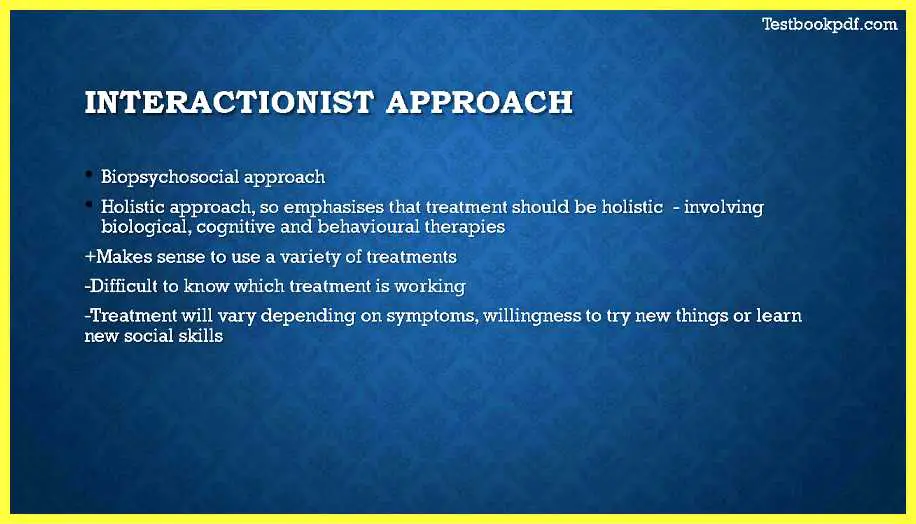
This is the biopsychosocial approach and a list approach that she emphasizes that treatment should be holistic involving biological cognitive and behavioral therapies obviously it makes sense to use a variety of treatments but it’s difficult to know which treatment is actually working and helps to improve the situation and treatment also vary depending on symptoms willingness to try new things and learn new social skills.
